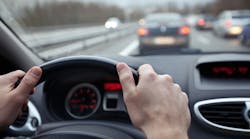We often assign names, titles to actions that otherwise are nothing more than risk-based decisions. Distracted driving unfortunately is one of them.
This is the story of JB who had his entire life ahead of him with a very young daughter, a promising career and a loving family. He often shrugged off his family’s objections to him texting while driving; after all, what is the risk? He was young, strong and on top of the world. He felt as though the family’s constant nagging was a way for them to show him they really cared. He was right. They loved him and the person he was becoming. JB’s family saw the risk he was taking and did not see the benefit of his actions, his habit.
One day, JB continued on his way as he always did, texting and driving. Only this time, he was involved in a car accident and paid for it with his life when he was ejected from his vehicle. You see, JB conducted a value-based risk assessment, compared it to his risk tolerance and then grounded his decision on an unrealistic justification. His predicted result did not materialize because Jake failed to properly evaluate the actual risk he undertook against the consequences he needed to reconcile by engaging in distracted driving.
The bottom line is that JB traded the chance to share his daughter’s graduations, proms, walks on the beach, father-daughter talks and life’s best moments for the opportunity to reportedly text this last message: “yeah t”. In fact, he also gambled away his daughter’s father. Now she does not have one, not by her choice, but by a decision her father consciously elected to make.
As the following ZeroFatalities video shows, too often, the driver isn’t the only one impacted by cell phone distractions while driving. Experience it from four points of view:
Zero Fatalities: Reggie Shaw’s Story
This unfortunate story repeats itself every day to someone somewhere. Icebike.org, Virginia Tech Transportation Institute, Drive Smart Virginia and others report these shocking distracted driving statistics:
- Over 2.5 million people in the U.S. are involved in road accidents each year, of these, 1.6 million or 64 percent of all road accidents involve cell phone use.
- Over 37,000 people die in automobile crashes in the U.S every year.
- Each year, over 330,000 accidents caused by texting while driving lead to severe injuries. This means that over 78 percent of all distracted drivers are distracted because they have been texting while driving.
- 1 out of 4 car accidents in the US are caused by texting while driving.
- Texting and driving is 6 times more likely to get you in an accident than drunk driving.
- It takes an average of three seconds after a driver’s mind is taken off the road for any road accident to occur. Reading a text message while driving successfully distracts a driver for a minimum of five seconds each time.
- The average speed in the US is about 55 mph. Taking five seconds to read a text in this time means that the driver travels the length of a football field without looking at the road.
- When you text while driving, the time that you spend with your eyes off the road increases by about 4 times.
- The chances of a crash because of any reason is increased by 23 times when you are texting. Even if the crash is another driver’s fault, you will probably have been able to avoid it if you had been looking at the road instead of the phone.
- Every day, 11 teenagers die because they were texting while driving.
- Ninety-four percent of teenagers understand the consequences of texting and driving, but 35 percent of them admitted that they do it anyway.
- Teen drivers have a 400 percent higher chance of being in a car crash when texting while driving than adults.
- Twenty-five percent of teens respond to at least one text while driving, every single time.
- Ten percent of adults and 20 percent of teenagers have admitted that they have entire conversations over text message platforms while driving.
- Eighty-two percent of American teenagers own a cell phone, and use it regularly to call and text message. 52 percent of these talk on the phone while driving, and 32 percent text on the road.
- When polled, 77 percent of adults and 55 percent of teenage drivers say that they can easily manage texting while driving.
- A study at the University of Utah found out that the reaction time for a teen using a cell phone is the same as that of a 70 year old who isn’t using one.
- Forty-eight percent of kids in their younger teenage years have been in a car while the driver was texting. Over 1,600 children in the same age group are killed each year because of crashes involving texters.
These statistics voice the reality of these heartfelt stories. The numbers represent people, loved ones.
Visit TextingAndDrivingSafety.com for more stories, more lives that were forever changed by the decision to engage in distracted driving.
Be “that” person for “that” someone who demonstrates leadership in this regard. Distracted driving, by any other name, is a decision based on unsubstantiated justifications.
Weigh the decision of this action, distracted driving, against the choice of that consequence, losing your life – or ending the life of someone else, and determine if, from a risk perspective, it is worth the chance to take it.
JB’s family argues that the price for his distracted driving was too high of a consequence to pay.
Would yours agree?
